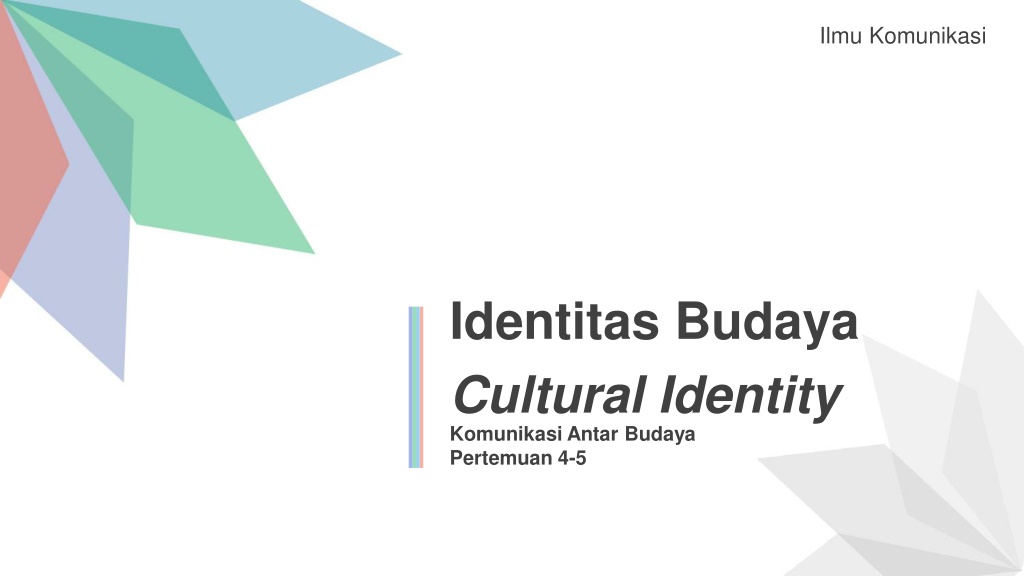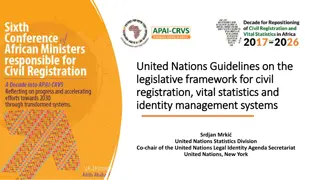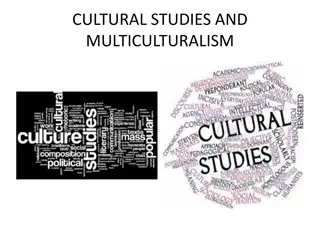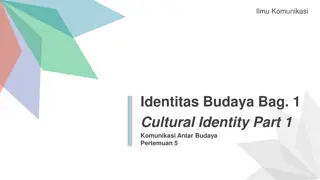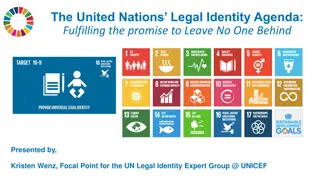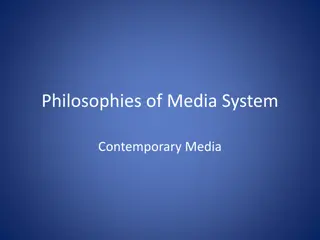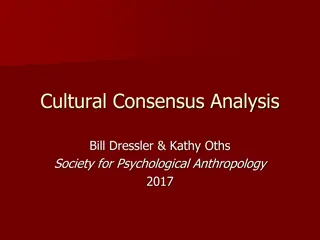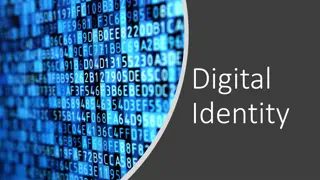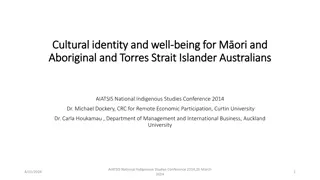Understanding Cultural Identity in Communication Studies
The importance of identity in communication is discussed in relation to cultural, racial, ethnic, gender, national, regional, organizational, personal, and cyber/fantasy identities. Identity development influences social roles and communication interactions. Various social identities shape our self-definition and interactions in diverse contexts. The abstract and dynamic concept of identity is explored, highlighting its reflective self-conception and the meanings we associate with shared symbols and behaviors.
- Cultural Identity
- Communication Studies
- Identity Development
- Intercultural Communication
- Social Identities
Download Presentation

Please find below an Image/Link to download the presentation.
The content on the website is provided AS IS for your information and personal use only. It may not be sold, licensed, or shared on other websites without obtaining consent from the author. Download presentation by click this link. If you encounter any issues during the download, it is possible that the publisher has removed the file from their server.
E N D
Presentation Transcript
Ilmu Komunikasi Identitas Budaya Cultural Identity Komunikasi Antar Budaya Pertemuan 4-5
Who are you? Write down ten words that you think describe you
The Importance of Identity Identity development plays a critical role in the individual s psychological well-being. 1 An understanding of identity is also an essential aspect of the study of intercultural communication 2 The unsettled world that we all live in is in part influenced by adherence to varying perceptions of identity 3 Identity influences and guides expectations about your own and others social roles, and provides guidelines for your communication interaction with others. 4 Samovar et all. 2010. Communication Between Cultures
Explaining Identity The abstract, complex, and dynamic concept A person s self-definition as a separate and distinct individual, including behaviors, beliefs, and attitudes Gardiner and Kosmitzki. Reflective self-conception or self-image that we each derive from our family, gender, cultural, ethnic, and individual socialization process. Identity basically refers to our reflective views of ourselves and other perceptions of our self-images. Ting-Toomey. Cultural identity (Fong): The identification of communications of shared system of symbolic verbal and nonverbal behavior that are meaningful to group members who have a sense of belonging and who share traditions, heritage, language, and similar norms of appropriate behavior. Cultural identity is a social construction. Samovar et all. 2010. Communication Between Cultures
Selected Social Identities Remember! We have more than one identity. 01 Racial Identity 02 Ethnic Identity - Mongoloid - Caucasoid - Negroid - Capoid - Australoid Derived from a sense of shared heritage, history, traditions, values, similar behaviors, area of origin, and in some instances, language. 03 04 Gender Identity National Identity The meanings and interpretations we hold concerning our self-images and expected other-images of femaleness and maleness . (Ting- Toomey) Refers to your nationality Samovar et all. 2010. Communication Between Cultures
Selected Social Identities Remember! We have more than one identity. 05 Regional Identity 06 Organizational Identity Every country can be divided into a number of different geographical regions, and often these regions reflect varying cultural traits. In some cultures, a person s organizational affiliation can be an important source of identity. 07 08 Personal Identity Cyber and Fantasy Identity Consist of those characteristics that set one apart from others in his or her in-group, those things that make one unique, and how one sees oneself. The internet provides an opportunity to escape the constraints of everyday identities. (Suler) Samovar et all. 2010. Communication Between Cultures
Acquiring and Developing Identities Three-stage Model from Phinney Final stage Second stage Ethnic Achievement First stage Ethnic identity search Unexamined ethnic identity Samovar et all. 2010. Communication Between Cultures
Acquiring and Developing Identities Four-stage Model from Martin and Nakayama Final stage Third stage Integration Second stage Resistance and separatism First stage Conformity Unexamined identity Based on how they were achieved, your identities can also be classified as ascribed or avowed. This refers to whether your identities were obtained involuntarily or voluntarily. Samovar et all. 2010. Communication Between Cultures
Establishing and Enacting Cultural Identity The communication employed to create and enact identity can take a variety of forms, including conversation, commemorations of history, music, dance, ritual, ceremonial, and social drama of all sorts. Identity can be displayed in cultural rites of passage. Samovar et all. 2010. Communication Between Cultures
Identity in Intercultural Interactions Your culture has shaped your understanding and expectations as to what are the correct communication practices for various social setting. However, this understanding are cultural bound, and what is appropriate in one culture may be inappropriate in another. In order to communicate effectively in an intercultural situation, an individual s avowed cultural identity and communication style should match the identity and style ascribed to him or her by the other party. Samovar et all. 2010. Communication Between Cultures
Identity in Multicultural Society Cultural Identity becomes blurry in the midst of cultural integration, bicultural interracial marriages, adaptation processes. Chuang. interactions, the mutual and Intercultural transients (Omwumechilli et al): Travelers who regularly alternate residence between their homeland and a host foreign country and must manage frequent cultural changes and identity negotiations. Issues of identity can be expected to remain complex and perhaps become more so as multiculturalism increasingly contemporary society. characterizes Samovar et all. 2010. Communication Between Cultures
The Dark Side of Identity Stereotyping Stereotyping is a complex form of categorization that mentally organizes your experiences with, and guides your behavior toward, a particular group of people. It becomes a means of organizing your perceptions into simplified categories that can be used to represent an entire collection of things or people. The reason for the pervasive nature of stereotypes is that human beings have a psychological need to categorize and classify. The world is too big, too complex, and too dynamic to comprehend in all its detail. Hence, you tend to classify and pigeonhole. Stereotypes can be positive or negative. Those that refer to a large group of people as lazy, coarse, vicious, or moronic are obviously negative. There are, of course, positive stereotypes, such as the assumption that all Asian students are hardworking, well mannered, and intelligent. Samovar et all. 2010. Communication Between Cultures
LEARNING STEREOTYPES When do we learn stereotypes? Remember, you are not born with stereotypes; they are learned, and like culture, they are learned in a variety of ways. The most obvious, and perhaps most important, agent of stereotypes is the socialization process, which begins with our parents. While many parents try to avoid teaching their children to think in stereotypes, we tend to agree with Schneider when he notes that often parents directly or indirectly actually promote them. Many stereotypes are generated by the mass media and widely disseminated through a variety of formats such as advertisements, movies, and TV sitcoms, soap operas, and reality shows. Television has been guilty of providing distorted images of many ethnic groups, the elderly, and gay people. Media has also played a role in perpetuating certain stereotyped perceptions of women and men. Samovar et all. 2010. Communication Between Cultures
why stereotypes hamper intercultural communication? First, stereotypes are a kind of filter; they only allow in information that is consistent with information already held by the individual. In this way, what might be the truth can be filtered out. For example, women were stereotyped for many years as a rather one-dimensional group confined to the role of homemaker. That stereotype often kept women from advancing in the workplace. Second, it is not the act of classifying that creates intercultural problems. Rather, it is the assumption that culture-specific information applies to every member of a particular cultural group. Stereotypes conjecture that all members of a group have exactly the same traits. Third, stereotypes also keep you from being a successful communicator because they are oversimplified, exaggerated, and overgeneralized. Stereotypes distort because they are based on half-truths and often- untrue premises and assumptions. Guirdham reaffirms this important point when he notes that stereotypes alter intergroup communication because they lead people to base their preparation, transmission, and reception of messages on false assumptions. Fourth, stereotypes are resistant to change. Samovar et all. 2010. Communication Between Cultures
How to avoid stereotypes? Let s discuss it!
The Dark Side of Identity Prejudice Prejudice generalization about a group of people or things, often based on little or no factual experience. Prejudice can be positive (liking a certain group or thing) or negative (disliking a certain group or thing). occurs when a person holds a The Functions of Prejudice (1) The ego-defensive function allows individuals to hold a prejudice while denying to themselves that they possess negative beliefs about a group. (2) The utilitarian function permits people to believe that their prejudicial beliefs produce a positive outcome. This is often found in situations where economic gain is involved. In Ruscher, the negative feelings and attitudes held by those who hold a prejudicial perspective are often exhibited through the use of group labels, hostile humor, or speech that alleges the superiority of one group over another. a communication setting, according to (3) The value-expressive function occurs when people maintain their prejudice in the belief that their attitudes represent the highest and most moral values of the culture. (4) The categorize, organize, and construct their perceptions of other people in a manner they see as rational even if that perception is woefully inaccurate. Samovar et all. 2010. Communication Between Cultures knowledge function enables people to
EXPRESSIONS OF PREJUDICE First, prejudice can be expressed through what Allport refers to as antilocution, which involves talking about a member of the target group in negative and stereotypical terms. The fourth level of prejudice involves physical attacks, which often escalate in hostility and intensity if left unchecked. The fifth, and most alarming, form of prejudice is extermination. This expression of prejudice leads to acts of physical violence with the objective of removing or eliminating all or major segments of the target group community. Second, people act out prejudice through avoidance. This occurs when people avoid and/or withdraw from contact with the disliked group. Third, when discrimination is the expression of prejudice, the prejudiced person will attempt to exclude all members of the group in question from access to certain types of employment, residential housing, political rights, educational and recreational opportunities, churches, hospitals, or other social institutions. Samovar et all. 2010. Communication Between Cultures
CAUSES OF PREJUDICE (1) Societal sources: A great deal of prejudice is built into the major organizations and institutions of a society. According to Oskamp, these organizations produce norms, rules, regulations, and laws that give rise to societal prejudice and help maintain the power of the dominant groups over subordinate ones. (2) Maintaining social identity: At the beginning of this chapter we pointed out the important role that identity plays in connecting people to their culture. This link is very personal and emotional because it creates the bond that binds people and culture together. (3) Scapegoating: Scapegoating occurs when a particular group of people, usually a minority, is singled out to bear the blame for certain events or circumstances, such as hardships, that adversely affect the dominant group. economic or social Samovar et all. 2010. Communication Between Cultures
How to avoid prejudice? Let s discuss it!
The Dark Side of Identity Racism Racism is the belief in the inherent superiority of a particular race. It denies the basic equality of humankind and correlates ability with physical composition. Thus, it assumes that success or failure endeavor will depend endowment rather than access to opportunity. ~ Leone in any societal genetic upon environment and The idea of superiority allows one group of people to mistreat another group on the basis of race, color, national religion, or sexual preference. origin, ancestry, Samovar et all. 2010. Communication Between Cultures
EXPRESSIONS OF RACISM Personal racism consists of racist acts, beliefs, attitudes, and behaviors on the part of the individual persons. Referring to institutional racism, Bloom is very specific when he writes, Institutional racism refers to racial inferiorizing or antipathy perpetrated by specific social institutions such as schools, corporations, hospitals, or the criminal justice system as a totality. Samovar et all. 2010. Communication Between Cultures
AVOIDING RACISM First, try to be honest with yourself when deciding if you hold any racist views. It is a simple point to state, but a difficult one to accomplish. Yet, confronting personal racist views is an important first step. Second, object to racist jokes and insults whenever you hear them. This daring and sometimes courageous message to other people that you denounce racism in whatever form it may take. act will send a Third, as straightforward as it sounds, respect freedom. Fourth, examine the historical roots of racism. Samovar et all. 2010. Communication Between Cultures
The Dark Side of Identity Ethnocentrism Ethnocentrism is the notion that one s own culture is superior to any other. It is the idea that other cultures should be measured by the degree to which they live up to our cultural standards. We are ethnocentric when we view other cultures through the narrow lens of our own culture or social position. ~ Nanda and Warms. Samovar et all. 2010. Communication Between Cultures
CHARACTERISTICS OF ETHNOCENTRISM Ethnocentrism Contributes to Cultural Identity Another reason ethnocentrism pervasive is that it provides members of a culture with feelings belonging. Levels of Ethnocentrism positive, negative, and extremely negative. is so of identity and Ethnocentrism Is Universal Most people are ethnocentric, and a certain degree of probably is essential if people are to be content with their lives and if their culture is to persist. ethnocentrism Ethnocentrism is strongest in moral and religious contexts, where emotionalism may overshadow rationality and cause the type of hostility.
AVOIDING ETHNOCENTRISM First, try to avoid dogmatism. Second, learn to be open to new views.
Any questions? Thank you
